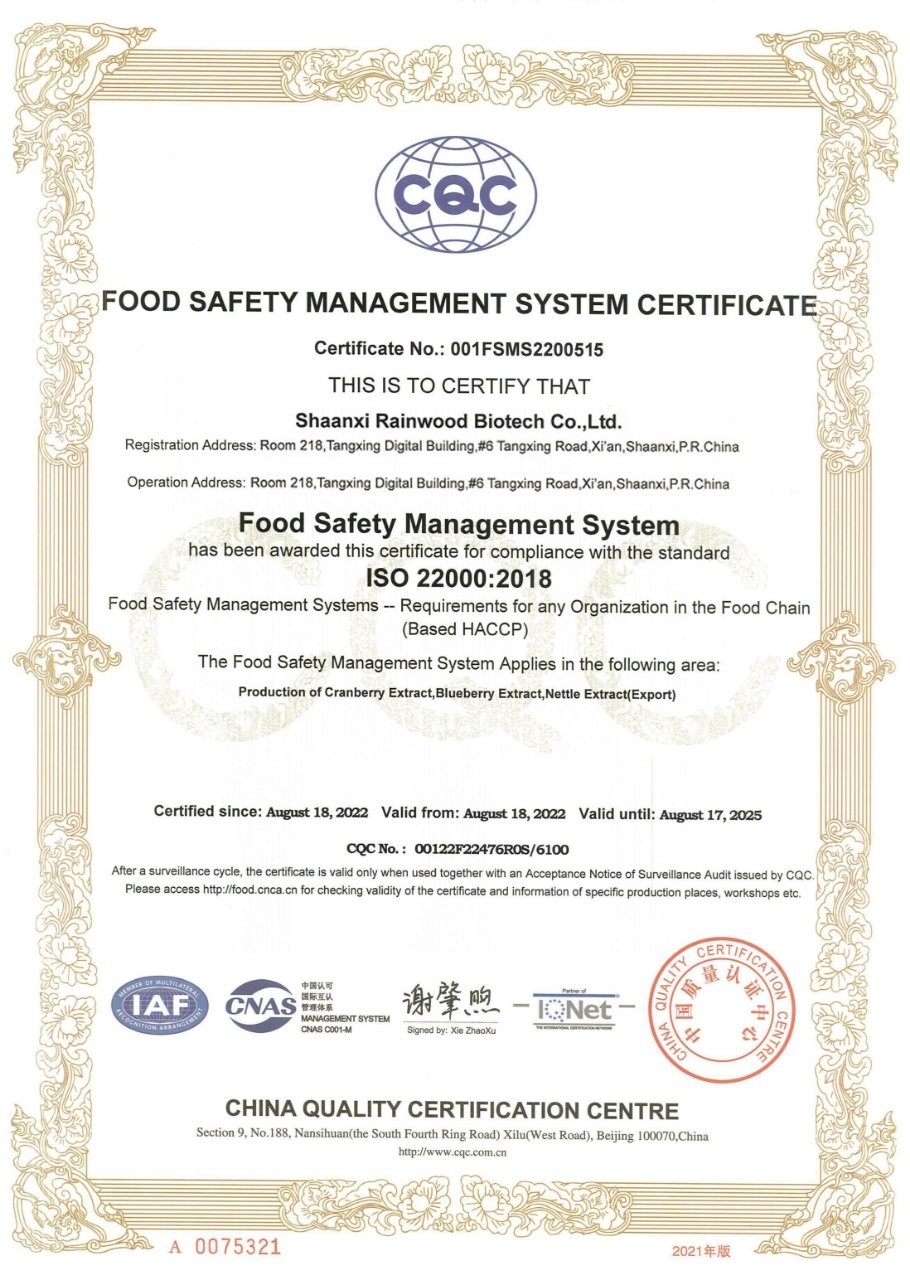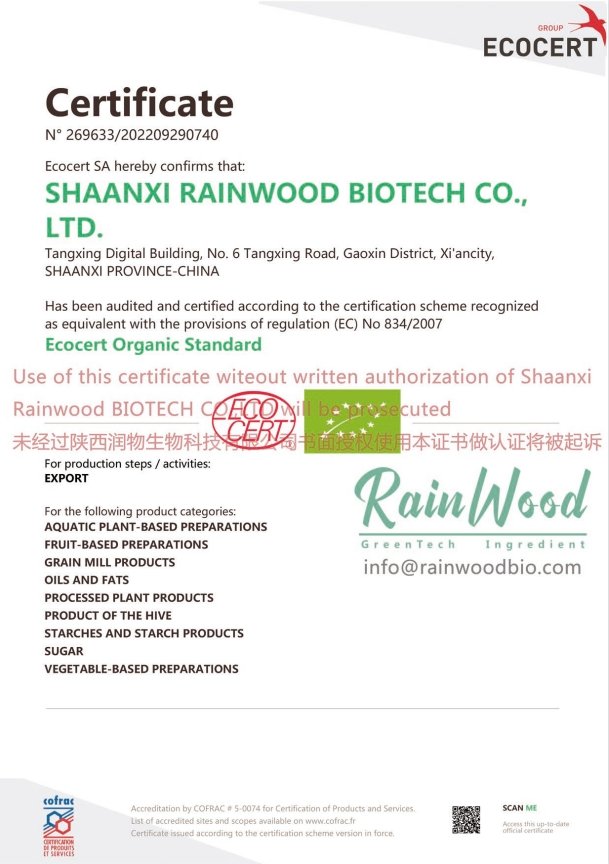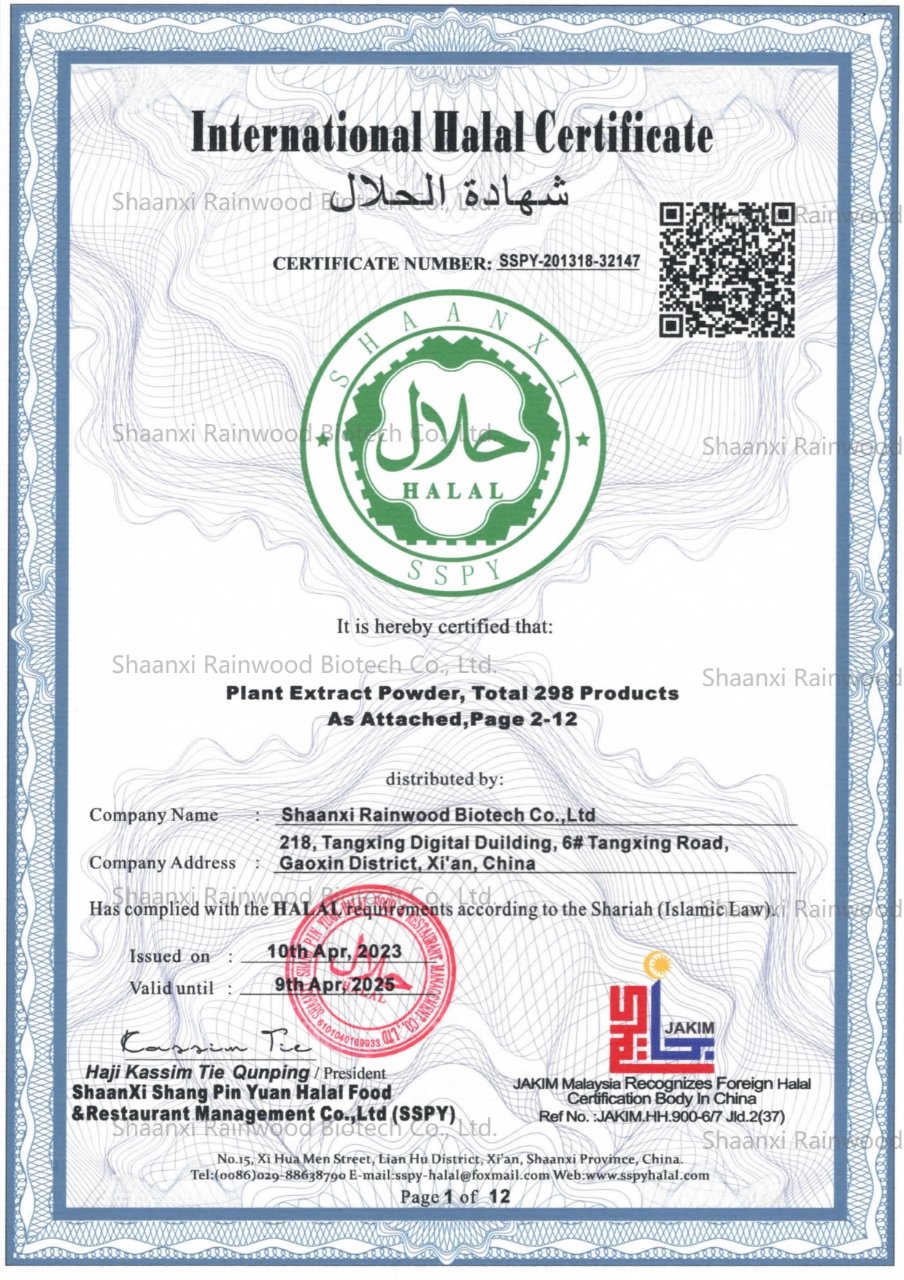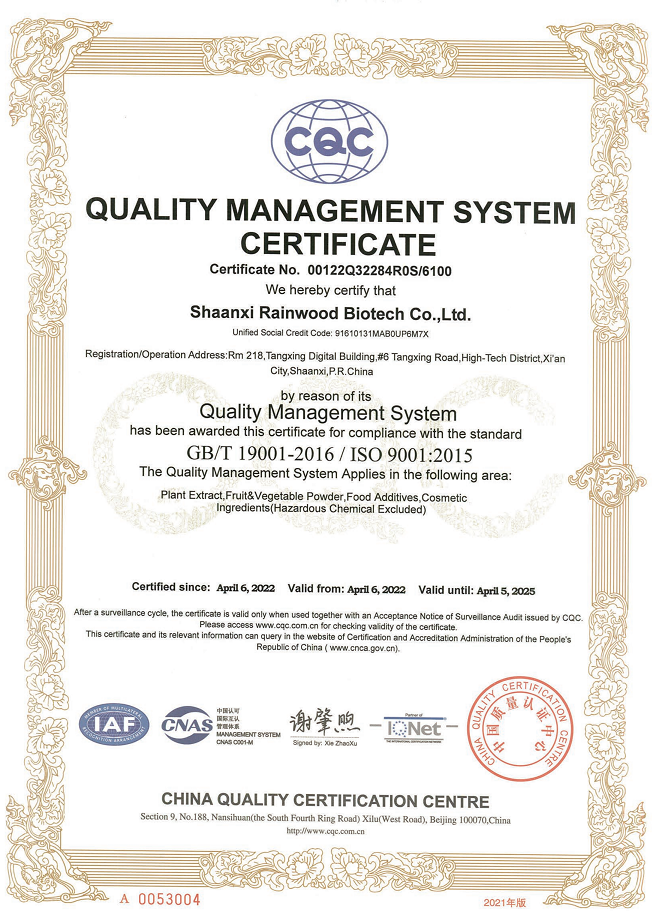How important are skin lipids
There are two types of lipids on the surface of human skin, sebaceous gland lipids and intercellular lipids. Although these two lipids are produced in different places and have different compositions, they work together to protect the skin.
The first type, physical barrier
In the classic “brick-mortar” model, the intercellular spaces from the spinous layer to the stratum corneum are filled with cement-like “intercellular lipids”. On the one hand, with the connection of desmosomes, they make the arrangement of the “bricks” more neat and compact; more importantly, they are an important barrier to prevent the ingress and egress of substances.
In damaged skin, sebum is like broken cement. There are a lot of gaps between the bricks, and any substance can easily pass through. But healthy sebum is like filled cement, which cannot be blown in by the wind and water.
Shaanxi Rainwood Biotech Co., Ltd. have professional production of Ceramide and other products for 15 years, is recognized as a professional plant extract manufacturers
The second type, chemical immunity
Many components in sebum are signal pathway factors responsible for regulating various biochemical reactions. For example, the ceramide we are going to talk about today is the second messenger of lipids, which regulates cell differentiation and apoptosis. It is directly related to skin inflammation and stress response.
The third type, flora immunity
On the one hand, sebum with a reasonable structure is conducive to the growth of skin flora and can also inhibit the excessive reproduction of harmful bacteria. On the other hand, the microorganisms on the skin surface produce metabolites during the continuous consumption of sebum, which in turn affects the secretion and synthesis of sebum.
The role of cement is so important that it is mainly composed of three components, ceramide, cholesterol and fatty acids. Among them, the content of ceramide is the highest, generally accounting for about 45-55% (some say that it is 40-50%, which is different for different groups of people), followed by cholesterol and fatty acids, which account for 20-25% and 15-20%, respectively.

What is ceramide?
Ceramide is a naturally occurring lipid in the skin. Ceramide forms a waterproof barrier on the surface of the skin. They not only help the skin to lock in moisture, but also promote the self-repair of the skin barrier and regulate skin cells. The skin of a newborn baby is often covered with a waxy substance. This substance is called fetal fat and is mainly composed of ceramide, which prevents the loss of skin moisture. The secretion of ceramide in the skin will decrease with age, which will cause dry skin, wrinkles and some skin inflammation.

From its chemical structure, ceramide is composed of sphingosine long-chain bases (accounting for ~50% of the structure) and a fatty acid. Different combinations of sphingosine bases and fatty acids form different ceramides.
Currently, 9 naturally occurring ceramides have been discovered. In addition, there are phytoceramides, psuedoceramides and synthetic ceramides.
Ceramide: a natural wax lipid that is pure in the skin. Consists of a long chain of sphingosine bases and a fatty acid
Phytoceramide: The sphingosine bases that make up it are commonly found in yeast, plants and some mammalian cell tissues. Don’t be confused by the ” plant” in the name.

Ceramide-like: It is also a lipid, similar in properties to ceramide but different in structure. For example, Ceramide E and Arachidamide MEA are both ceramide-like. Ceramides are usually artificially synthesized, but there may also be naturally occurring forms.
Synthetic ceramide: artificially synthesize naturally occurring ceramide.
In most cases, the ceramide used in cosmetics is synthetic (whether it is ceramide or ceramide-like), because the content of ceramide in plants is too low and it is too expensive to extract from animals. Whether it is synthetic or natural extraction, as long as the chemical structure is the same, the same effect can be achieved.
Although everyone looks alike, the effect and content in the skin are still very different. The highest content is Ceramide 3 (NP), followed by Ceramide 7 (AH) and Ceramide 5 (AS).

Where does ceramide come from?
Where does ceramide come from the stratum corneum of the skin? Where is it made? You should really be curious.
Ceramide exists in all cells of the human body and is involved in the regulation of cell functions in a complex manner.
Sphingolipids (Sphingolipids) are biologically active components that are ubiquitous in cells.
According to research on cell physiology and pathology, it has been shown that \”Ceramide plays an important role in the process of inflammation, cell stress and cell apoptosis.\”
However, to play such an important role in cell physiology, this ceramide needs to be made by the cell itself to work! And it has to stay in living cells to have any effect! When the ceramide is distributed to the border and to the dead stratum corneum, the only job is to be a cement wall, and it will no longer be physiologically active.

Rainwood BIO-committed to plant extract research and development, has more than 15 years experience, certified with ISO9001, ISO22000, KOSHER, HALAL, ORGANIC CERTIFICATE. You will get the cheapest price and best quality from us. Welcome for your inquiry.
https://www.rainwoodbio.com/products/ceramide/
Let’s learn how ceramide comes from. Simply put, such a powerful biochemical synthesis and multi-enzyme-participating project, only vigorous living cells have such requirements.
The three main sources of ceramide:
(1) It is synthesized in the endoplasmic reticulum in the cell. (It happens in living cells)
(2) Sphingomyelin, a component of the cell membrane, is decomposed by sphingomyelin catalyzed by sphingomyelin. (It happens in living cells)
(3) The formed ceramide is hydrolyzed by Ceramidase into Sphingosine and free fatty acids. Sphingosine re-enters the synthesis pathway of ceramide and re-forms ceramide under the catalysis of ceramide synthase. (It happens in living cells)
Why is the ratio of ceramide in the stratum corneum so high?
The skin is an external organ, especially the epidermis, which plays the role of protecting the human body through cell differentiation and keratinization. During the keratinization process of the entire epidermal layer, the changes in lipid composition are indeed very dramatic. The area with the highest ceramide content is not in the live cell area where ceramide is produced, but in the dead cuticle area. Perhaps this is to make the stratum corneum (especially the outer area) competent for the role of the retaining wall, and the natural differentiation of cells is a natural wonder!
How poor is the moisturizing effect of different types of ceramides?
From the perspective of the ceramide possessed by the skin itself, of course, the larger the molecular weight, the less likely it is to be dissolved by any solvent, and the more non-polar ceramide, the more it can be firmly stuck in the stratum corneum, and it will be more secure. The task of home defense.
However, from the point of view that skin care products are applied to fill the \”wall gap\”, this large molecular weight, non-polar ceramide that can not be dissolved in a suitable solvent at all, means that it is \”completely unusable.\”
You can\’t think that \”grind the ceramide powder into a very fine powder and mix it into the cream or essence\”, so there is a chance to \”stuff the ceramide into the wall\”! If this is also possible, can the \”powder\” of foundation, powder, and BB cream get stuck in the stratum corneum?
Of course not! Therefore, the ceramide that can be dissolved is certainly not the \”most moisturizing\”. But don\’t be discouraged, because the most powerful and moisturizing products can\’t be used as skin care products.
In fact, it can also be noticed that many brands use not Ceramide, but the synthetic ceramide material-Sphingosine (Sphingosine). The skin is rubbed with sphingosine, phytosphingosine (Phytosphingosine) or glycosphingolipids (Glycosphingolipids), there is no problem, no side effects, and laws and regulations of various countries also allow it. However, don\’t be naive to think that these three components will \”transform\” into ceramide in the skin.
You can\’t think that if you apply some fatty acids to the skin at the same time, these two ingredients can combine into ceramides like a thunder. When it comes to the dead skin area, all the components of the skin have reached the scrapped area to be removed, and they are no longer able to undertake such a difficult project as \”synthetic ceramide\”.
You have to ask again, what is the maintenance meaning of sphingosine, phytosphingosine and glycosphingolipids? I also want to know! For skin, the literature discusses almost all ceramides. We can only boldly speculate that the biocompatibility of these \”raw materials for synthetic ceramide\” with the skin is good and non-rejective. But what is the degree of contribution? If the ultimate value of ceramide is moisturizing, then the value of these raw materials may not have many advantages to create other new values!
Does ceramide have whitening and anti-aging effects?
As for the involvement of ceramide in the production of melanin, the survival and apoptosis of palm cells, the addition of ceramide in skin care products can whiten and resist cell aging… That is really wonderful. These are the physiological activities of ceramide in living cells in the basal layer. The structure of the ceramide here is so precise and correct that it is a specific type of the more than four hundred ceramide configurations in the human body. The simple rough classification of ceramides in cosmetics has no chance to be the same, no chance to be delivered to the work area, no chance to participate in such a biochemical operation event.
Is there any experiment to prove its ceramide effect?
Many studies have confirmed the efficacy of ceramide, but we need to pay attention to two issues. One, some of these experiments do not use blind testing or comparative experiments. Therefore, even if the experimental results show that ceramide is effective, we cannot know whether a product without ceramide can achieve the same effect. The second problem is that there are too many types of ceramides. In addition, the added concentration and matching ingredients can be ever-changing, so we can\’t confirm which ceramide and which combination works best. Nevertheless, in general, a large amount of experimental data shows that ceramide is beneficial to skin care. Below we quote several research data.
A Japanese study showed that compared with placebo, ceramide extracted from plants can strengthen the skin\’s moisturizing function.
A mouse experiment published in the Journal of Clinical and Experimental Dermatology found that topical ceramide can not only repair the skin barrier, but also protect the skin from surfactant stimulation.

The Kao Group of Japan published a study showing that a can of cream containing 8% Ceramide E can increase skin moisture content and improve atopic dermatitis. But the experiment has neither blind testing nor comparison experiments. It is worth noting that many experiments have used a concentration of 8%, but in fact the content of ceramide in skin care products is generally less than 1%.
It is mentioned in The Textbook of Cosmetic Dermtology that certain ceramide compound formulas can have a better repair effect (compared to a placebo).
An article called \”Skin-identical lipids versus petrolatum\” pointed out that ceramides are no different from mineral oils. The experiment tested a mixture containing ceramide-3, cholesterol, oleic acid and palmitic acid. At the same time, they also said that perhaps because the ratio of ceramide to other lipids did not reach the ideal ratio, the experimental results were not ideal.
There is also a relatively novel point of view. Instead of replenishing the lost ceramide by external use or orally, we can prevent its loss. There is an enzyme called ceramid-ases in our skin, which specifically breaks down ceramide. Theoretically, if we can control the number of ceramid-ases, we can keep the ceramide in the skin. At present, we have only found one related study, but because it is difficult to separate ceramid-ases from the skin, researchers obtained this enzyme from feces and nasal excrement.



















